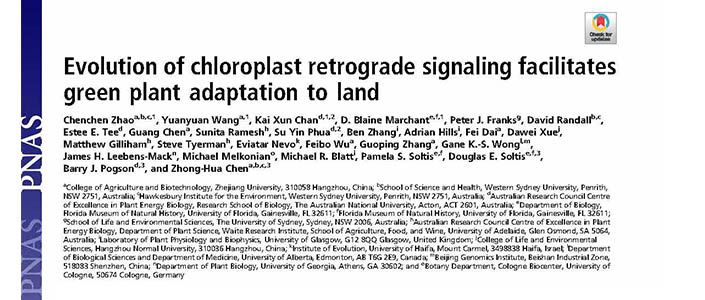PNAS:浙大、西悉尼大學丨植物耐旱和氣孔進化新機理

期刊:PNAS
主題:植物耐旱和氣孔進化新機理
標題:Evolutionof chloroplast retrograde signaling facilitates green plant adaptation to land
影響因子:9.504
檢測指標:K+、Ca2+、Cl−
作者:浙江大學/西悉尼大學陳仲華
英文摘要
Chloroplast retrograde signaling networks are vital for chloroplastbiogenesis, operation, and signaling, including excess light and drought stresssignaling. To date, retrograde signaling has been considered in the context ofland plant adaptation, but not regarding the origin and evolution of signalingcascades linking chloroplast function to stomatal regulation.
We show that key elements of the chloroplast retrograde signalingprocess, the nucleotide phosphatase (SAL1) and 3′-phosphoadenosine-5′-phosphate (PAP)metabolism, evolved in streptophyte algae—the algalancestors of land plants.
We discover an early evolutionof SAL1-PAP chloroplast retrograde signaling in stomatal regulation based onconserved gene and protein structure, function, and enzyme activity and transitpeptides of SAL1s in species including flowering plants, the fern Ceratopterisrichardii, and the moss Physcomitrella patens.
Moreover, we demonstrate thatPAP regulates stomatal closure via secondary messengers and ion transport inguard cells of these diverse lineages. The origin of stomata facilitated gasexchange in the earliest land plants.
Our findings suggest that the conquest of land by plants was enabled byrapid response to drought stress through the deployment of an ancestralSAL1-PAP signaling pathway, intersecting with the core abscisic acid signalingin stomatal guard cells.
中文摘要(谷歌機翻)
葉綠體逆行信號傳導網絡對于葉綠體的生物發生,操作和信號傳導至關重要,包括過量的光和干旱脅迫信號。迄今為止,已經在陸地植物適應的背景下考慮了逆行信號傳導,但沒有考慮將葉綠體功能與氣孔調節相關聯的信號級聯的起源和進化。
我們顯示葉綠體逆行信號傳導過程的關鍵元素,核苷酸磷酸酶(SAL1)和3'-磷酸腺苷-5'-磷酸(PAP)代謝,在陸生植物的藻類祖先 - 鏈霉菌藻類中進化。
我們發現SAL1-PAP葉綠體逆行信號在氣孔調節中的早期進化基于保守基因和蛋白質結構,功能和酶活性以及物種中SAL1s的轉運肽,包括開花植物,蕨類植物Ceratopteris richardii和苔蘚Physcomitrella patens。
此外,我們證明PAP通過第二信使調節氣孔關閉和這些不同譜系的保衛細胞中的離子轉運。氣孔的起源促進了早的陸地植物的氣體交換。
我們的研究結果表明,通過部署祖先的SAL1-PAP信號通路,與氣孔保衛細胞中的核心脫落酸信號相交,對干旱脅迫的快速反應使植物征服土地成為可能。

Fig. 3. PAP-induced stomatal closure, guard-cell ROS and NO signaling, and ion transport are evolutionarily conserved across plant clades. (D–F) PAP regulates K+,Cl−, and Ca2+ fluxes from guard cells of three major clades. Data are averaged for control (0–10 min) and PAP (15–35 min). Data are means ± SE (n = 5–8).
 您好, 歡迎來到化工儀器網
您好, 歡迎來到化工儀器網
